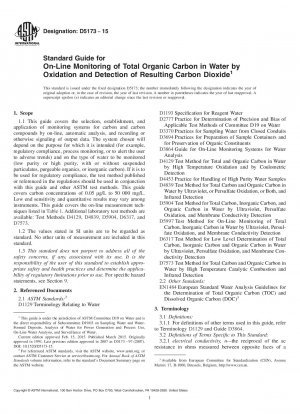ASTM D5173-15
Standard Guide for On-Line Monitoring of Total Organic Carbon in Water by Oxidation and Detection of Resulting Carbon Dioxide
- Standard No.
- ASTM D5173-15
- Release Date
- 2015
- Published By
- American Society for Testing and Materials (ASTM)
- Status
- Replace By
- ASTM D5173-15(2023)
- Latest
- ASTM D5173-15(2023)
- Scope
5.1 Accurate measurement of organic carbon in water at low and very low levels is of particular interest to the electronic, life sciences, and steam power generation industries.
5.2 Elevated levels of organics in raw water tend to degrade ion exchange resin capacity. Elevated levels of organics in high purity water tend to support biological growth and, in some cases, are directly detrimental to the processes that require high purity water.
5.3 In power generation, naturally occurring organics can become degraded to CO2 and low molecular weight organic acids that, in turn, are corrosive to the process equipment. Their effect on conductivity may also cause water chemistry operating parameters to be exceeded, calling for plant shutdown. Halogenated and sulfonated organics may not be detectable by conductivity but at boiler temperatures will release highly corrosive chlorides, sulfates, etc.
5.4 In process water in other industries, organic carbon can signify in-leakage of substances through damaged piping and components, or an unacceptable level of product loss.
5.5 In wastewater treatment, organic carbon measurement of influent and process water can help optimize treatment schemes. Measurement of organic carbon at discharge may contribute to regulatory compliance.
5.6 In life sciences, control of organic carbon is necessary to demonstrate compliance with regulatory limits for some types of waters.
1.1 This guide covers the selection, establishment, and application of monitoring systems for carbon and carbon compounds by on-line, automatic analysis, and recording or otherwise signaling of output data. The system chosen will depend on the purpose for which it is intended (for example, regulatory compliance, process monitoring, or to alert the user to adverse trends) and on the type of water to be monitored (low purity or high purity, with or without suspended particulates, purgeable organics, or inorganic carbon). If it is to be used for regulatory compliance, the test method published or referenced in the regulations should be used in conjunction with this guide and other ASTM test methods. This guide covers carbon concentrations of 0.05 µg/L to 50 000 mg/L. Low end sensitivity and quantitative results may vary among instruments. This guide covers the on-line measurement techniques listed in Table 1. Additional laboratory test methods are available: Test Methods D4129, D4839, D5904, D6317, and D7573.
(A) Consult manufacturer for specific range of measurement.1.2 The values stated in SI units are to be regarded as standard. No other units of measurement are included in this standard.
1.3x0......
ASTM D5173-15 Referenced Document
- ASTM D1129 Standard Terminology Relating to Water
- ASTM D1193 Standard Specification for Reagent Water
- ASTM D2777 Standard Practice for Determination of Precision and Bias of Applicable Methods of Committee D-19 on Water
- ASTM D3370 Standard Practices for Sampling Water from Closed Conduits
- ASTM D3694 Standard Practices for Preparation of Sample Containers and for Preservation of Organic Constituents
- ASTM D3864 Standard Guide for Continual On-Line Monitoring Systems for Water Analysis
- ASTM D4129 Standard Test Method for Total and Organic Carbon in Water by High Temperature Oxidation and by Coulometric Detection
- ASTM D4453 Standard Practice for Handling of Ultra-Pure Water Samples
- ASTM D4839 Standard Test Method for Total Carbon and Organic Carbon in Water by Ultraviolet, or Persulfate Oxidation, or Both, and Infrared Detection
- ASTM D5904 Standard Test Method for Total Carbon, Inorganic Carbon, and Organic Carbon in Water by Ultraviolet, Persulfate Oxidation, and Membrane Conductivity Detection
- ASTM D5997 Standard Test Method for On-Line Monitoring of Total Carbon, Inorganic Carbon in Water by Ultraviolet, Persulfate Oxidation, and Membrane Conductivity Detection
- ASTM D6317 Standard Test Method for Low Level Determination of Total Carbon, Inorganic Carbon and Organic Carbon in Water by Ultraviolet, Persulfate Oxidation, and Membrane Conductivity Detection
- ASTM D7573 Standard Test Method for Total Carbon and Organic Carbon in Water by High Temperature Catalytic Combustion and Infrared Detection
ASTM D5173-15 history
- 2023 ASTM D5173-15(2023) Standard Guide for On-Line Monitoring of Total Organic Carbon in Water by Oxidation and Detection of Resulting Carbon Dioxide
- 2015 ASTM D5173-15 Standard Guide for On-Line Monitoring of Total Organic Carbon in Water by Oxidation and Detection of Resulting Carbon Dioxide
- 1997 ASTM D5173-97(2007) Standard Test Method for On-Line Monitoring of Carbon Compounds in Water by Chemical Oxidation, by UV Light Oxidation, by Both, or by High Temperature Combustion Followed by Gas Phase NDIR or by Electrolytic Conductivity
- 2001 ASTM D5173-97(2001) Standard Test Method for On-Line Monitoring of Carbon Compounds in Water by Chemical Oxidation, by UV Light Oxidation, by Both or by High Temperature Combustion Followed by Gas Phase NDIR or by Electr

Copyright ©2024 All Rights Reserved